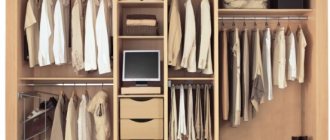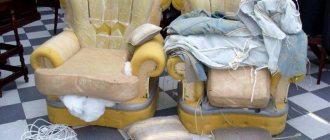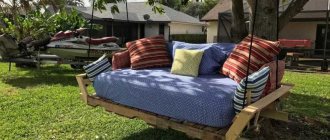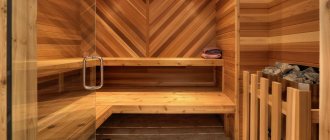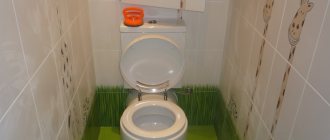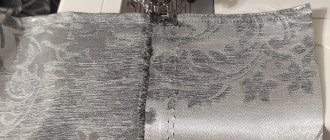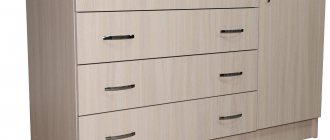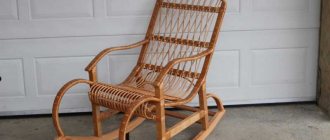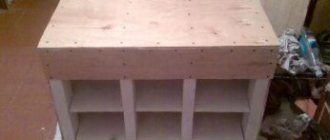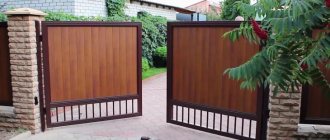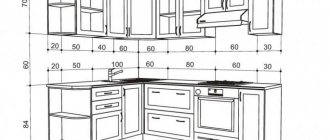Children's furniture standards
Furniture factories always adhere to certain standards when manufacturing their products. When making furniture with your own hands, it is important to adhere to these standards and requirements that furniture intended for children must meet.
- Safety is the main criterion when making furniture for children. All corners of furniture must be rounded to prevent the child from getting hurt while playing. Furniture elements should not contain small elements that can easily be torn off. Particular attention should be paid to the fittings, which must be securely attached. It is advisable to cover the edges of furniture with protective film.
- Environmentally friendly. Children's furniture must be made from natural materials. Wood, plywood or cardboard are best. Varnishes and paints applied to furniture must be non-toxic. This photo shows homemade original children's furniture made of cardboard.
- Simplicity and strength. Make the simplest pieces of furniture, without unnecessary details. Children's furniture should be strong and durable. Nails cannot be used as fastenings, as this is not safe for the child.
- Design. The children's play area can be decorated in bright colors. For example, red, yellow, orange are perfect for this purpose. Accordingly, furniture can be painted in bright colors or pasted over with a variety of pictures. A corner for passive activities (drawing, modeling, learning the alphabet) should be decorated in light blue or blue tones, as this color scheme promotes brain function and concentration.
- Functionality. To rationally use the space in the children's room, the furniture can be equipped with drawers in which toys and children's things will be stored.
Catalog
Integrated equipment for preschool institutions is a complex and serious issue that requires a responsible approach. To create convenience and comfortable conditions for students and staff, a huge number of pieces of furniture are required. It is necessary to purchase children's beds, various cabinets, chairs, tables, toys and many other daily necessary things that must be practical, of high quality and comply with established sanitary, hygienic and environmental standards. In addition, all furniture and interior items should have a modern design, be combined with each other and contribute to the creation of comfort. You also need equipment for the catering department, medical furniture, and furniture for the manager’s office.
Ours can help you solve this problem. Integrated turnkey provision of kindergartens, nursery groups, as well as schools and office premises with furniture and equipment is the main focus of our activity. Therefore, in the “Catalogue” section of the website you will find a complete list of furniture, interior design and necessary accessories for organizing the play and educational process of preschoolers.
The catalog of our Avocado-shop store contains all the necessary reference and information information about the products offered, which are conveniently grouped into sections: children's play furniture, custom-made furniture, office furniture, educational kits, outdoor complexes for children's playgrounds and others. Here you can find a general list of products from one group. To get acquainted in detail with the piece of furniture, toy or equipment that interests you, you can follow the link directly to the model page, where its detailed description, characteristics and cost are indicated. This will help save time for kindergarten managers and employees, contract managers involved in the search and purchase of equipment. You don't have to look for what you need on other sites and companies. By visiting our catalog, you can easily select the required equipment for your kindergarten or school. In addition, you can simply order turnkey equipment for your premises.
Having a catalog will help you compare items from the same category and make the right choice. You can get more detailed advice on the consumer properties of the products you are interested in by calling our managers. If you are in Moscow and the Moscow region, you can invite an Avocado representative to your place, who will introduce you to product samples, answer all questions and provide assistance in choosing equipment. But even if you are equipping a kindergarten located far from the capital: in Bryansk, Tver, Chelyabinsk, Nizhnevartovsk or Nefteyugansk, then our catalog will become an assistant in resolving your issues and will help you place an order for the necessary goods. Delivery is carried out by transport companies anywhere in Russia.
Materials for children's furniture
The best option for making children's furniture is natural wood or its derivatives. The use of plastic elements is allowed.
You can make children's furniture from cardboard or foam rubber.
Natural wood is the best material for children's furniture.
- This is an environmentally friendly, durable and easy-to-work material.
- The budget option for wood is pine, and the most durable is oak or walnut; you can also use maple or beech.
- Furniture made from natural wood can last for many years.
The most popular materials for the production of any furniture in our time are chipboard or laminated chipboard, but furniture made from these materials is not desirable for a children's room, since chemicals are used in their production.
MDF is a material similar to chipboard, but no chemicals are used in its production, so it is quite suitable for making children's furniture.
Plywood is an environmentally friendly material that is easy to work with. The main thing is that the plywood sheets have a thickness of more than one and a half centimeters and the material is resistant to moisture.
Cardboard is a lightweight, inexpensive material that is easy to use. The disadvantage of cardboard is that it is not moisture resistant.
Foam rubber is used to make upholstered furniture for children's rooms. It is a lightweight, safe and budget-friendly material.
Manufacturing materials
A wide range of materials are used to produce play furniture intended for kindergartens. Moreover, regardless of the type, the base must be environmentally friendly, safe and wear-resistant to ensure high-quality operation of the products.
| Material type | Purpose | Examples of using | Advantages | Flaws |
| Tree | Outdoor structures/furniture for play areas. | Playhouses, swings, sandboxes. Shelving, modules. | Eco-friendly, in the case of the house, well ventilated, durable. | Requires regular painting and treatment with impregnations when used outdoors. |
| Plastic | Outdoor designs, indoors. | Playhouses, swings, sandboxes, slides, modules. | Eco-friendly, low maintenance, impact resistant, can be easily assembled and disassembled. | At low temperatures (-18o C) deformation may occur. |
| PVC | Street/room. | Playhouses, trampolines, slides, tunnels. | Light, elastic, no sharp corners, bright, children like them. Suitable for younger ages. | If the quality of the material is poor, there may be an unpleasant odor and the release of allergens. |
| Chipboard, MDF, laminated chipboard | For premises. | Shelving, modules, frames. | Economical, strong material, wear-resistant. Ability to produce the most complex designs. | May release harmful substances if production technology is violated. |
| Foam rubber, polystyrene foam | Interior premises. | Fillers for upholstered play furniture. | They provide high-quality upholstery of the frame and maintain its shape. | They have a certain service life. Then they must be replaced. |
The production of furniture for preschool institutions is strictly regulated. Manufacturers undertake to follow established GOST standards and have on hand documents confirming the quality and safety of the materials used.
PVC
Array
Plastic chipboard
MDF
Foam rubber
DIY play furniture
Do-it-yourself children's play furniture will undoubtedly delight any child, because he can take part in the process of its creation - tell the parent what exactly he wants to see in his room.
There are many options for arranging a play area in a children's room. You can make a wall bars, a mini-climbing wall, a slide, a house or a boat. Place a sofa, ottomans or children's chairs nearby.
Making children's play furniture with your own hands is very interesting, but this process requires attention and careful thought through all the elements of the play area.
Making a playhouse yourself is not at all difficult.
- To do this, you need to take measurements of the place where you plan to install the structure.
- Then, make a drawing of the house to cut out the parts exactly to size.
- For a plywood house you will need sheets at least ten millimeters thick.
- Draw the necessary parts on the plywood and slowly cut them out using a jigsaw.
- Then sand the edges of the parts with sandpaper. Cut out the windows and doors in detail, then you can begin assembling the structure.
- The parts can be joined together using small nails, furniture corners and wood glue.
- You can paint the house with acrylic paints. You can also install lighting in the form of LED lamps.
A Swedish wall can be made from pine boards and cuttings from gardening tools.
- Make holes in the main post where the cutting steps will be placed.
- The finished structure can be painted or varnished.
- Attach the product to the wall using metal corners.
- There should be at least three corners on each side; drive an anchor through the hole in the corner.
- A children's wall bars must withstand a load of 121 kilograms.
Kinds
Designers offer “professionally oriented” furniture for playrooms, complexes of several modules, made in accordance with the age characteristics of children, promoting motivation for play activities - taking on roles, performing algorithms:
- for girls you can find kitchens, hairdressers, dressing rooms, doctor's offices, store counters;
- for boys in the children's room, play furniture for kindergartens is produced in the form of transformer modules, from which children can jointly assemble a car, or the walls of a fortress - actively interact with it.
All furniture in a kindergarten, for outdoor or indoor use, must comply with a whole list of sanitary and hygienic requirements and be safe for students.
The choice of children's play furniture for kindergartens when planning an area is carried out in accordance with the requirements of the Federal State Educational Standard, based on the age of the pupils and the number of children in groups. An important role in the arrangement process is played by the opinion and initiative of parents - part of the furnishings can be done with your own hands, subject to compliance with all standards.
Children's toy furniture involves arranging corners for role-playing games. Here, toy houses become an integral part, in which children can learn socially significant skills in a playful way. At the same time, not only girls, but also boys can play in the houses - the latter are often assigned the role of guests coming for tea. The boys' "house" can be stylized as a garage or a captain's bridge.
You can divide play furniture for kindergarten into the following categories:
- outdoor - houses, modules with swings, slides, sandboxes;
- for interior spaces - plastic houses, tents, role-playing modules, transformer modules.
In the first case, the structures are static. Made from impact-resistant, moisture-resistant materials - wood, plastic and metal structures. Materials are painted in bulk or using special impregnations, wood or metal paints.
In the case where children's furniture is intended for use in a group, it can be made:
- with a rigid, static frame;
- in the form of collapsible modules;
- children's soft play furniture, from which pupils can build sofas, cars, boats, and other furnishings.
Furniture items also take into account the possibility of storing children's toys.
For the street
For kindergartens, outdoor children's play furniture is designed primarily to meet children's needs not only for communication and interaction, but also for physical activity. Manufacturers offer entire complexes made in accordance with the requirements of SanPin, environmental safety and the characteristics of the psychophysiological development of preschool children. If parents take on the task of organizing playgrounds and want to set up a playground with their own hands, you need to enlist the support of a specialist who is knowledgeable about safety standards and requirements. This means that play furniture as in the photo must have the following qualities:
- stability, reliable fixation on the ground. Children's temperament is activity, mobility, a desire to experiment, to shake the structure. Whether it’s a slide, a swing, or a section with a basketball hoop, the module must remain motionless and prevent the structure from falling;
- the absence of sharp corners is another important factor in preventing injuries;
- the material used is impact-resistant, guaranteed to withstand the declared weight load;
- the design must have comfortable non-slip steps and railings, reliable fences;
- decorative, movable elements are securely fastened. Joints, hinges, bearings are closed to prevent pinching of clothing, child’s skin, fingers;
- surfaces are easy to clean if necessary, resistant to sanitary treatment.
Outdoor play furniture for children will become a real field of miracles if you choose and install it wisely. When installing swings, houses, and slides, adults should remember that, despite manufacturers’ assurances about the safety of the products, children should play outside under the supervision of teachers.
For indoors
Furniture for a children's playroom, according to the recommendations of the Federal State Educational Standard, should have multifunctionality, the ability to modify the environment and contribute to the development of spatial perception, motor skills, and imagination. While serving as a toy, furniture must remain a reliable and safe piece of furniture:
- Manufacturers make transformable tables, chairs, racks for toys, “hair salon” and “doctor’s offices” modules for girls, garages and ships, houses for boys from high-quality, certified materials - natural beech, laminated chipboard, bent plywood;
- the metal frame is coated with polymer powder paint;
- Water-based varnish is preferred as a coating;
- products made from wood panels or plastic must be odorless, without any harmful substances that can cause illness to children in the room or cause allergies;
- sharp corners are contraindicated - the outlines of the parts should have rounded protruding parts;
- Children's furniture may contain drawers, sections for toys, while all parts are securely fixed, and fasteners are securely closed with plugs. No protruding nails or screws.
Children's soft play furniture consists of modular elements with which a child can build a house, a car or design another object. The various designs and shapes of such modules allow children to find replacement toys and gain a wide variety of experiences.
Upholstered furniture for kindergartens, used as play furniture, can be of 3 types:
- frame - the product is based on a frame made of metal or wood filled with foam rubber, which is covered with fabric on top. Flock is often used for these purposes - it is abrasion resistant and easy to care for;
- frameless or filling type - similar to the well-known bean bag chair. Penoplex as a filler allows you to give such a module a bag absolutely any shape. For children, such a product provides real scope for imagination and experimentation. This option is easy to manufacture and parents can make such modules with their own hands;
- soft-filled - here, in addition to foam rubber, vinyl artificial leather is used. The material is easy to care for, does not stretch, and is economical in cost.
There are modifications equipped with wheels for movement. This could be furniture in the shape of animals, which the child can ride on while sitting astride. At the same time, the elastic upholstery will reliably soften the blow in the event of a fall.
Play areas
The arrangement of a play space in a kindergarten should include the following points:
- opportunity for outdoor games - there should be enough space for children to be active;
- furniture for role-playing games. This includes houses, “kitchen” type complexes, where there are kitchen utensils, sets of dishes and products, a toy medical office, a hairdresser, a store - or a colorful rack with a window that can become a pharmacy or a post office;
- racks and containers for toys. After all, one of the important functions of the play area is to teach children order;
- special boards or sections of the wall with a washable coating on which students can draw.
When organizing your space, you should take into account that boys can be more active than girls. Children should not interfere with each other while playing.
Playhouses
Manufacturers of play furniture offer a large selection of houses for children of different ages. These can be “home” and outdoor structures. Most of them are easy to assemble, so even girls can handle the device. This is important, because they are often the ones who make up the kindergarten staff:
- For younger children, inflatable models are recommended. There are no sharp corners here; the floor acts as a trampoline. Children will happily run and frolic inside such a house. Another option is a tent house in the form of an Indian wigwam or a fairy-tale tent. The disadvantage of such options is their lightness and instability. With high activity, children can turn it over;
- houses made of cardboard - suitable for older preschoolers. These structures can be painted, giving the house the look of your choice;
- plastic structures - quite compact in size for indoor use; street options are larger, may have 2 floors, extensions in the form of slides, ropes, ladders or swings;
- wooden houses - used outdoors, they can become a smaller copy of a log house or tower.
When giving preference to a house model, be sure to take into account the conditions of its use, the age of the pupils, and their needs. Will it be a compact model or a spacious option with space for toys. For mixed groups, it is better to choose a universal design that is suitable for boys and girls playing.
Children's furniture made of cardboard
Children's room furniture made from cardboard is good quality, but not moisture resistant. To make furniture you need to use corrugated cardboard. Cardboard boxes should be from furniture or large household appliances.
- Making a chair or ottoman shaped like a cube is very simple.
- First you need to make a drawing on whatman paper in the shape of a square, to which you attach a rectangle.
- The resulting template should be in the shape of the letter “H” upside down.
- Using the template, cut out fifty pieces of cardboard of the same size and about one hundred strips, which will be equal in height to the future sofa.
- Also cut two hundred strips along the height of the seat. Glue the strips two at a time together.
- The result was spacers between the blanks. Glue gaskets to one of the blanks.
- Glue a long gasket in the back area. Short ones - in the seat area.
- Next, you need to glue the second blank to the resulting structure, and again glue the gaskets and the third blank to it.
Repeat the operation until the last piece is glued, after which the product should dry for 24 hours. After that, cover the structure with whatman paper, and then foam rubber and put on a cover.
Making a chair from thick foam rubber is even easier. To do this, you need to cut out five blanks in the shape of the letter “L”, which need to be glued together. Glue batting or felt onto the back and seat of the chair, and cover it with soft thick fabric.
Original do-it-yourself table
To make it interesting for your child to draw or play at the table, you can make a table from plywood in the shape of a tree. The table leg will imitate a tree trunk, and the tabletop will imitate the crown.
- Draw a table top-crown on a sheet of plywood and cut it out with a jigsaw.
- Sand the edges of the workpiece with sandpaper. Draw table legs on plywood, which should be the same size.
- The legs will need to be connected using a sawn lock. Drill holes in the tabletop to connect it to the legs.
- After connecting the parts of the legs, drill holes in their upper part to connect to the tabletop.
Prime and paint the table parts, and then assemble them into a single structure.

